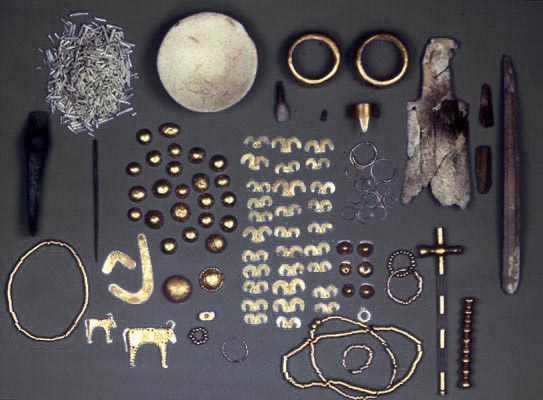Treasures from Chalcolithic Necropolis, town of Varna
Chalcolithic necropolis town of Varna-Treasures of Civilization from 5th millennium BC.  In 1974 while digging a trench in the region of the Varna Lake, 4 kilometers to the west of the town centre, some golden and silver items with a strange shape and decorations came to the surface. The experts were sure that the finds represent burial objects, gifts to those, buried in the chalcolithic necropolis dating back to the 5th millennium about 4200-4000 BC. These findings became famous all over the world with the name Varna Necropolis Treasure, and the civilization to whom it belonged – Varna Culture. 7500 sq. m. are examined so far – 294 tombs and over 3000 beautiful and exquisite gold items, weighing about 6,5 kg (14 lb) were found. In the necropolis (necro-polis «city of the dead») the archaeologists found three different types of burial and ways of laying the mortal remains:
In 1974 while digging a trench in the region of the Varna Lake, 4 kilometers to the west of the town centre, some golden and silver items with a strange shape and decorations came to the surface. The experts were sure that the finds represent burial objects, gifts to those, buried in the chalcolithic necropolis dating back to the 5th millennium about 4200-4000 BC. These findings became famous all over the world with the name Varna Necropolis Treasure, and the civilization to whom it belonged – Varna Culture. 7500 sq. m. are examined so far – 294 tombs and over 3000 beautiful and exquisite gold items, weighing about 6,5 kg (14 lb) were found. In the necropolis (necro-polis «city of the dead») the archaeologists found three different types of burial and ways of laying the mortal remains:
- on their back with the body stretched
- curled up in a ball with legs and arms tucked in, resembling the position of the embryo in mother’s womb
- symbolic burials — there were no bodies in the tombs, only burial gifts were found. (practice for paying honour to the deceased who had fallen dead far away, in battle, while travelling or for other reasons preventing the burial of the mortal remains)
Rich burial items are found by each one of the three kinds of burial. The items were intended to accompany the buried people after death. These were clay vessels, sea shells, numerous decorative objects made of precious and base metals, as well as bone human figures representing idols. In their hands were put instruments like knives, axes, chisels made of stone, copper or flint. The richest in gold items are the empty tombs of the symbolic burials. There were also vessels and instruments. Symbolic human faces made of clay surrounded by rich decoration were found in some of the tombs. In only one of the excavated tombs (Nr 43 regarding its unearthing) were found 990 gold items weighing over 1,5 kg (3.3 lb). The burial in tomb 43 was made over 4000 years BC. The unearthed remains belong to a male, about 45 years old, who was athletic and relatively tall of stature (170 cm), having in mind the normal height at that time. He had massive gold bracelets on each hand, as well as strings of sea shells and gold beads. A splendid adornment resembling a wide collar decorated his neck and chest. It consisted of gold plates and jewels. These were also sewn on to his clothes and hat. In the tomb there were also many instruments made of copper and flint, and clay vessels. All these findings evidence that this was the tomb of a noble ruler or priest and also prove the existence of a well structured hierarchical society…
The finding seems to be the richest necropolis in Europe of the late Chalcolithic period. The civilization that existed on this territory was called Varna Culture. The gold items of the Varna Treasure are the world’s oldest worked gold. The treasure is exhibited in the halls of the Archaeological Museum in Varna.Video – The treasures from Chalcholithic necropolis town of Varna
View more treasures of ancient civilizations found in Bulgaria







